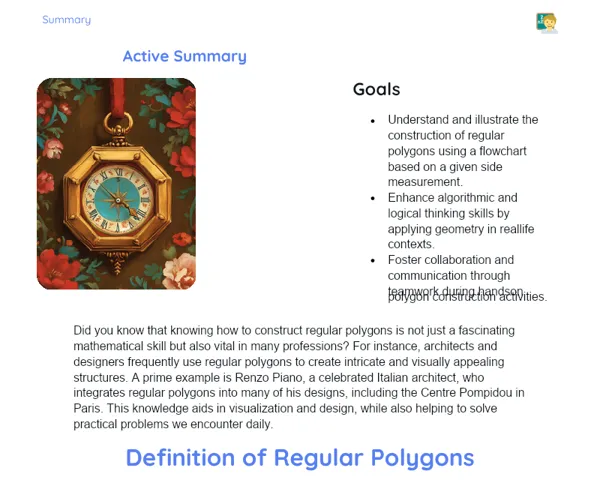Summary Tradisional | Exact Square and Cubic Roots
Contextualization
Today, we’re going to explore exact square and cube roots, which are basic mathematical operations important for understanding numbers and their properties. Just like addition and multiplication, roots are key concepts in mathematics with numerous practical applications. For example, when calculating the area of a square, we use the square root; similarly, finding the volume of a cube involves the cube root. Professions such as architecture, engineering, and computer science often rely on these operations, underscoring their significance in our daily lives.
Interestingly, the concept of square roots is very ancient, with origins tracing back to civilizations like the Babylonians, who calculated square roots on clay tablets over 4,000 years ago. Today, these mathematical principles play a vital role in modern technologies, from video game graphics to building designs, proving that, despite their long history, their relevance has only intensified over time. Therefore, mastering square and cube roots is crucial not just for academic success, but also for various practical scenarios in everyday life.
To Remember!
Definition of Square Root
The square root of a number is the value that, when multiplied by itself, gives the original number. For instance, the square root of 16 is 4 since 4 x 4 = 16. This fundamental concept in mathematics is denoted by the symbol √. When we calculate the square root of a number, we are identifying the number which, when squared (multiplied by itself), results in the original number.
However, not all numbers have exact square roots. For example, numbers such as 2 or 3 do not have exact square roots, as there isn't an integer that when multiplied by itself gives exactly 2 or 3. In such cases, the square root becomes an irrational number, which means it cannot be accurately expressed as a fraction.
Understanding square roots is vital for various mathematical operations and practical applications. For example, when determining the area of a square, we use the square root to calculate the length of the sides. This concept also finds relevance in fields like physics, engineering, and computing, where precise calculations are crucial.
-
The square root of a number is the value that, when multiplied by itself, gives the original number.
-
Not all numbers have an exact square root.
-
The square root is represented by the symbol √.
Examples of Exact Square Roots
To help students grasp the concept, it’s useful to provide examples of exact square roots for numbers ranging from 1 to 100. For example, the square root of 1 is 1, the square root of 4 is 2, the square root of 9 is 3, and this pattern continues up to the square root of 100, which is 10. These examples aid in visualizing how square roots function and noticing patterns.
It’s important to point out that some numbers, like 2, 3, 5, and 7, do not have exact square roots, resulting in irrational numbers. For instance, the square root of 2 is approximately 1.414, a figure that cannot be expressed as a precise fraction.
Recognizing which numbers have exact square roots and which do not is essential for solving mathematical problems. This understanding also familiarizes students with irrational numbers and their significance in advanced calculations.
-
Examples of exact square roots include the square root of 1 (1), 4 (2), 9 (3), up to 100 (10).
-
Some numbers, like 2, 3, 5, and 7, do not have exact square roots and yield irrational numbers.
-
It’s crucial to make a distinction between numbers that have exact square roots and those that do not.
Definition of Cube Root
The cube root of a number is the value that, when multiplied by itself three times, gives the original number. For example, the cube root of 27 is 3 because 3 x 3 x 3 = 27. This concept is represented by the symbol ∛ and is essential for understanding volumes and other three-dimensional properties.
Similar to square roots, not all numbers have exact cube roots. For instance, numbers like 2 or 3 do not have exact cube roots because there's no integer that, when multiplied by itself three times, results in exactly 2 or 3. In these situations, the cube root is also an irrational number.
Comprehending cube roots is vital for calculating volumes. For example, when we find the volume of a cube, we utilize the cube root to ascertain the length of the edges. This concept is notably important in fields such as architecture, engineering, and computer science, where a strong grasp of three-dimensional dimensions is crucial.
-
The cube root of a number is the value that, when multiplied by itself three times, gives the original number.
-
Not all numbers have exact cube roots.
-
The cube root is represented by the symbol ∛.
Examples of Exact Cube Roots
To aid in students’ understanding, it’s beneficial to compile a list of examples of exact cube roots for numbers up to 1000. For example, the cube root of 1 is 1, the cube root of 8 is 2, the cube root of 27 is 3, the cube root of 64 is 4, and so forth up to the cube root of 1000, which is 10. These examples provide clarity on how cube roots operate and allow students to spot patterns.
Moreover, it’s significant to highlight that some numbers, like 2, 3, 5, and 7, do not have exact cube roots, thus resulting in irrational numbers. For example, the cube root of 2 is approximately 1.26, which cannot be expressed as an exact fraction.
Understanding which numbers have exact cube roots versus those that don’t is essential for tackling mathematical challenges. This distinction helps students grasp irrational numbers better and recognize their role in more complex calculations.
-
Examples of exact cube roots include the cube root of 1 (1), 8 (2), 27 (3), up to 1000 (10).
-
Some numbers, like 2, 3, 5, and 7, do not have exact cube roots and yield irrational numbers.
-
It's important to distinguish between numbers that have exact cube roots and those that do not.
Key Terms
-
Square Root: value that, when multiplied by itself, gives the original number.
-
Cube Root: value that, when multiplied by itself three times, gives the original number.
-
Exact Number: number that has an exact square or cube root.
-
Inexact Number: number that does not have an exact square or cube root, leading to an irrational number.
-
Irrational Number: a number that cannot be expressed as an exact fraction.
Important Conclusions
In this lesson, we examined exact square and cube roots, understanding that the square root of a number is the value that, when multiplied by itself, results in the original number, whereas the cube root is the value that, when multiplied by itself three times, leads to the original number. We found that these operations are foundational to mathematics and have diverse practical applications in fields like architecture, engineering, and computer science.
We discussed detailed examples of exact square and cube roots, alongside numbers that do not have exact roots, leading to irrational numbers. Through lists of examples and comparisons, students were able to identify patterns and develop a clearer understanding of how these roots function.
Finally, we emphasized the significance of distinguishing between numbers with exact roots and those without, underlining the value of this knowledge in solving more complex mathematical problems. Mastery of these concepts is vital not just for academic success but also for various practical applications in everyday life.
Study Tips
-
Regularly practice calculating exact square and cube roots using the examples provided in class.
-
Review concepts of exact and inexact numbers, aiming to identify patterns and differences between them.
-
Explore practical applications of square and cube roots in real-life scenarios, like calculating areas and volumes.



